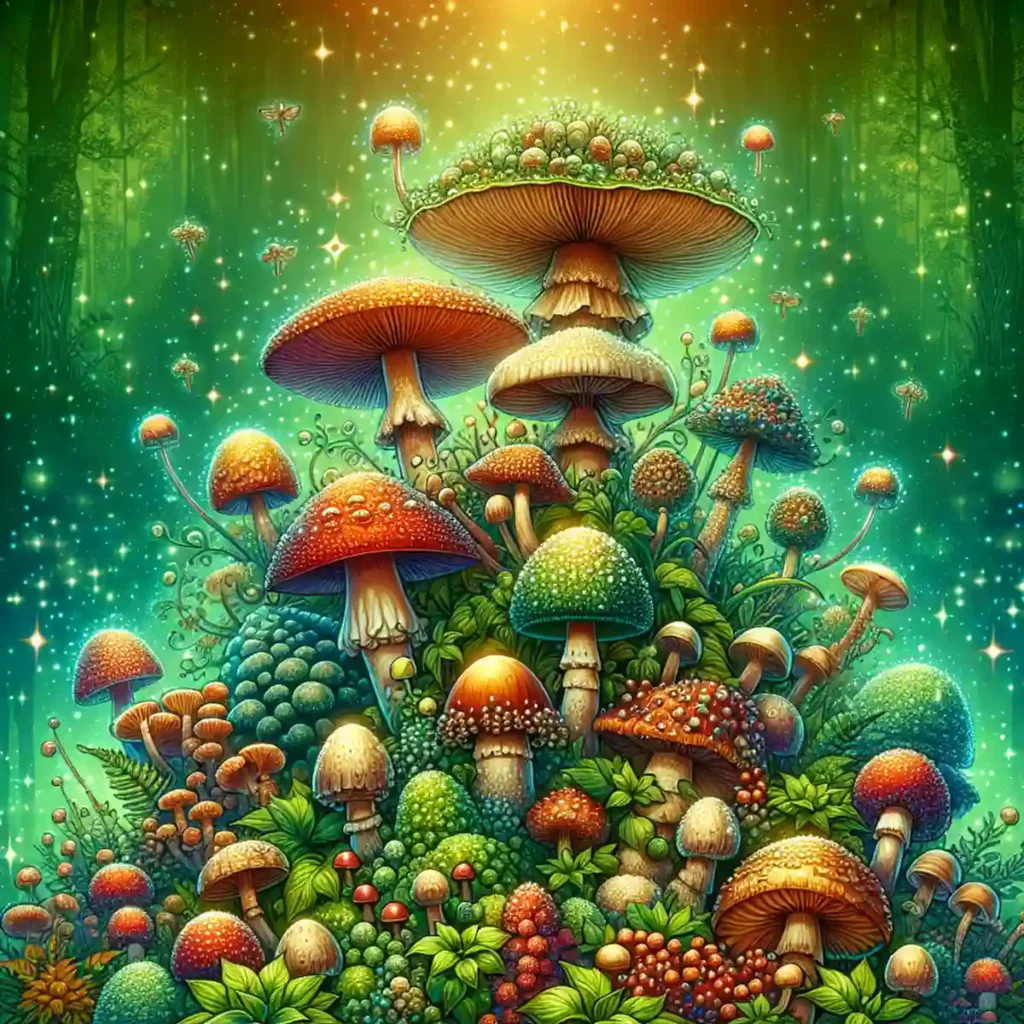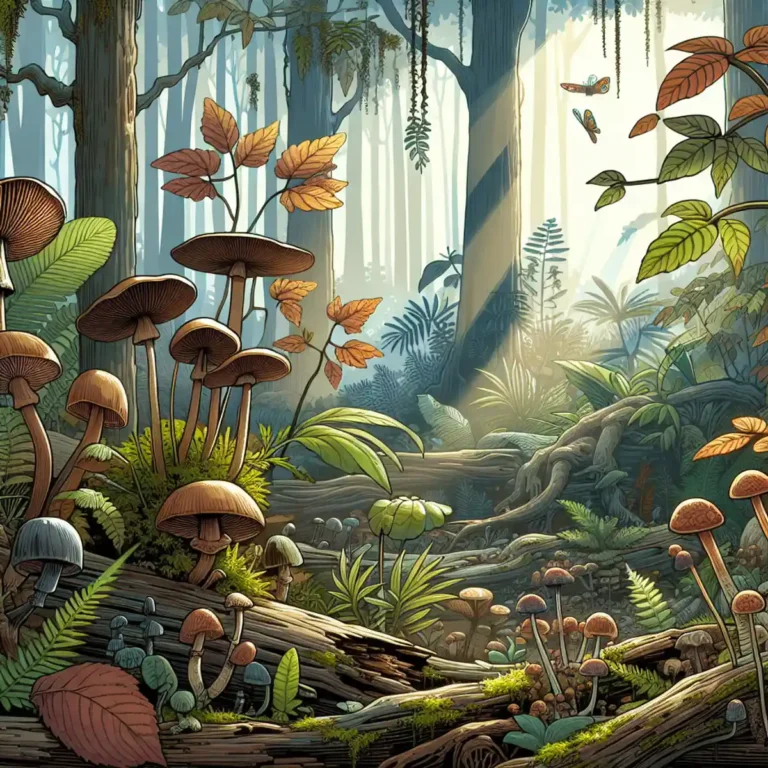Imagine a world without mushrooms, those enigmatic organisms quietly orchestrating life’s continuity from the shadows of the forest floor. Often overlooked, fungi perform indispensable duties that underpin entire ecosystems. Fungi’s pivotal role in the food chain is a tale of unseen influence and ecological necessity.
Their place in nature is unique; neither plant nor animal, fungi occupy a kingdom all their own, one that thrives on the very cycle of life and decay. As we delve into the inner workings of ecosystems, the spotlight often misses the quiet contribution of fungi, especially mushrooms, to the intricate web of existence.
This insightful article will unveil why mushrooms are vital to the food chain, exploring their roles as decomposers, symbionts, and even producers. Through a journey into organic matter breakdown, symbiotic relationships, and their unexpected nutritional benefits, prepare to discover the world of fungi like never before, illuminating their unheralded yet immense impact on our lives and the planet.

The Role of Fungi in the Food Chain
Fungi, a kingdom of life distinct from plants and animals, embody a critical role in our ecosystems, markedly impacting the food chain. These organisms are chiefly recognized as nature’s decomposers — they possess the unique ability to break down organic matter that many other organisms can’t. As decomposers, fungi consume dead plants, animals, and other organic material, recycling the nutrients and returning them to the soil. This creates an ongoing supply of critical organic molecules that become the building blocks for new life.
Among fungi, mushrooms are particularly noteworthy. Species like the Oyster mushroom not only decompose dead organic materials but can also break down pollutants, thanks to their potent chemical compounds, playing an essential role in detoxifying environments. Furthermore, through symbiotic relationships, such as mycorrhizal associations, fungi are invaluable partners to plants. By extending the root system of their hosts, they enhance water and nutrient uptake, showing that their role extends far beyond decomposition.
Without fungi like mushrooms to decompose organic matter, the cycle of nutrients would be halted, stifling the growth of new plants and, by extension, the entire food web aboveground. Their efficient dealing with organic material ensures that primary producers – plants – obtain the necessary nutrients to thrive, supporting primary consumers – herbivores – and secondary consumers – carnivores – and maintaining the delicate balance of our ecosystems.
Moreover, mushrooms serve directly as a source of food for various wildlife and even for humans. They are high in dietary fiber, proteins, vitamins, and minerals, making them prized as food and in food supplements. Companies such as Marlow Foods, leveraging the versatile nature of fungi, produce meat alternatives that enhance the food sector, giving insights into the significance and potential of mushrooms that extend beyond their ecological roles.
In summary, in the grand tapestry of the food chain, mushrooms and fungi at large are indispensable weavers that render the flow of life possible through their breakdown and creation of organic matter.

Understanding the Concept of the Food Chain
The food chain concept greatly simplifies the flow of energy and nutrients through an ecosystem. At its base, primary producers like plants harness chemical energy from the sun and convert it into organic compounds in a process called photosynthesis. These primary producers are then consumed by primary consumers – often herbivores – which form the next link in the chain. Secondary consumers, including carnivorous animals, follow by preying on these herbivores.
Fungi, which include diverse forms such as yeasts, mushrooms, and molds, fit uniquely in this chain. They are neither plant nor animal and do not photosynthesize. Instead, they acquire chemical energy stored in organic matter through decomposition. Acting as nature’s recyclers, they release organic molecules back into the environment once they have performed their digestive processes externally with enzymes that break down complex organic material.
Furthermore, the food chain extends to symbiotic relationships like those seen in lichens. Here, fungi form partnerships with algae, with both parties benefiting mutually; the algae produce food through photosynthesis, while the fungus offers a structure for growth and nutrient absorption. These complex interactions illustrate the intricate web of life, where energy is not merely passed along a linear path but shared among organisms in a dynamic balance.
The Unique Position of Fungi in the Food Chain
Fungi occupy a unique niche within the food chain; they are neither wholly producers nor consumers. Through processing dead organic material, they generate and recycle essential nutrients, catalyzing energetic flows within ecosystems. This role is not only beneficial but crucial; without fungi, the breakdown of tough substances like cellulose and lignin found in plant cell walls would be significantly impaired.
Many fungi enter into mutually beneficial partnerships with plants, exchanging nutrients and supporting the growth of vast networks of plants – an ecological role that defines much of the terrestrial life. These mycorrhizal relationships typify how fungi are entwined with the overall health of ecosystems, facilitating the transfer of nutrients between soil and plants, a critical service for both natural and agricultural landscapes.
On the darker side, some fungi can become antagonists in the food chain. Certain species are capable of decimating populations of plants by causing diseases or producing toxic compounds detrimental to both plant and animal life. The duality of fungi highlights their power within the food chain – as sustainers and potential destroyers.
Their decomposition action not only fosters soil fertility, propelling the growth of new plant life but also ultimately sustains food for herbivores and all subsequent links in the chain. Beyond their ecological duties, fungi, especially mushrooms, fulfill an essential role in human food systems. They are cultivated globally, adhering to standards regulated by entities such as the Food Standards Agency. Their wide range reflects diversity in both function and nutritional content, solidifying their place not just as decomposers or symbionts, but as a direct and indispensable food source.
In essence, the food web would unravel without fungi. The recyclers of nature, the partners of growth, and the providers of sustenance, fungi perform an essential role that supports life’s continuity.
Organic Matter Breakdown
Fungi, considered nature’s recycling system, undertake a pivotal task in ecosystems through the breakdown of organic matter. This includes mushrooms, which are adept at degrading tough materials such as cellulose and lignin found in wood. Many organisms lack the capability to digest these complex components, but fungi excel at it. This decomposition is not only a vital process for recycling nutrients but it also adds to the sustainability of life. Mushrooms, as decomposers, perform their task exter
nally, transforming the intricate structures of organic material into simple sugars that can be utilized as energy. Furthermore, their activity is beneficial not only to themselves but also to countless other organisms that cohabit the soil ecosystem. The organic molecules fungi liberate through decomposition provide a veritable buffet for the tiny life forms that maintain soil health.
Unprocessed dead and decaying matter can serve as a haven for pathogens, underlining the critical role fungi play in disease suppression and pest control. Additionally, mushrooms contribute substantially to the creation of humus. This rich organic substance is integral in enhancing the fertility and water-retention ability of the soil, reinforcing the overall health and resilience of ecosystems.
The Decomposition Process
As the unsung heroes of forest ecosystems, mushrooms occupy a significant niche in decomposing dead organic materials, such as fallen trees and leaves. Their actions are like a natural alchemy, converting lifeless wood back into fertile soil. These decomposers release vital nutrients as they work, which are then recaptured and repurposed by primary producers, ensuring a steady flow of life-sustaining elements.
In woody habitats, mushrooms’ ability to break down recalcitrant, fibrous material is indispensable for the transformation of dead wood into accessible nutrients. It’s a crucial service for trees and plants, enabling them to thrive. Moreover, the symbiotic relationships mushrooms establish with trees are fundamental to nutrient cycling. These relationships allow for an efficient exchange where the mushrooms absorb nutrients from the soil and transfer them to the trees, which in return provide the mushrooms with sugars.
Fungi as Decomposers
The role of fungi as decomposers, or saprotrophs, is paramount within ecological networks. They ingeniously break down the tough components of plants like lignin and cellulose, turning them into compounds more easily assimilated by other life forms. This process not only aids in nutrient cycling but also features additional advantages for larger organisms including humans.
Medicinal mushrooms, for example, harbor properties that support the immune system and contribute to overall wellbeing, showcasing the multifaceted benefits fungi provide beyond their decomposition function. Through their intricate mycelium networks, fungi are able to convert complex organic materials into simpler sugars, further fueling the life cycles of other organisms or enriching the soil for plants.
The Role of Mushrooms in Decomposition
Mushrooms stand out in their capacity to recycle nutrients back into ecosystems, a process integral to ecological balance. Their adept decomposition efforts help manage disease and pests by breaking down potential breeding grounds for harmful organisms. Moreover, this process culminates in enhanced soil health, with fungi contributing humus that bolsters soil fertility and water retention.
The chemical transformations triggered by mushrooms during decomposition liberate vital nutrients from decaying materials. These nutrients then re-enter the biotic cycle, rejuvenating the soil. The far-reaching effects of nutrient recycling by mushrooms are manifest not only in the immediate environment but also in sustaining a diverse community of plant and microbial life, thus furthering ecosystem equilibrium.
Symbiotic Relationships
Symbiotic relationships are essential to the balance and function of ecosystems, defining interactions where different species live in close biological association. In these partnerships, each organism contributes something the other needs. A prime example is the mycorrhizal relationship between fungi and plant roots. In this symbiosis, fungi play a critical role by transferring nutrients like phosphorus back to plants, which, in return, supply the fungi with carbohydrates generated through photosynthesis. This nutrient exchange is fundamental to supporting plant growth and vigor and has far-reaching implications for the entire food chain.
Without such associations, plants may struggle to obtain vital nutrients, leading to a cascading effect on the survival of plant-dependent herbivores and the predators that feed on them, ultimately disrupting the entire food chain. The mycorrhizal relationships that fungi form are vital for sustaining the vibrant mosaic of plant life that other organisms depend on, highlighting the complex interdependency of species in maintaining ecosystem health.
Exploring Symbiosis in the Natural World
In the intricate web of life, fungi like mushrooms emerge as pivotal agents of ecological balance. As decomposers, they tackle the daunting task of breaking down organic matter such as fallen leaves and decomposing wood. Their ceaseless work recycles essential nutrients, making them available to plants and thereby enriching the soil. Beyond decomposition, fungi also enter into mutualistic relationships, providing a glimpse into the nuanced interplay of life forms that sustain natural environments.
The absence of these versatile organisms would lead to a disrupted food chain, decreased biodiversity, and potential adverse consequences for wildlife and human populations alike. Recognizing the crucial role of fungi heightens our awareness of their importance and fuels our commitment to their preservation. Their involvement stretches across various ecological roles, ensuring the continuous flow of nutrients and maintaining the well-balanced dynamics crucial for life.
Fungi’s Symbiotic Relationships with Plants
Mycorrhiza, a form of symbiotic relationship, showcases the profound mutual benefit between fungi and plants. Fungi residing in plant roots extend their mycelium far into the soil, significantly expanding the boundary for nutrient absorption. They offer plants a range of advantages, from improved nutrient uptake to protection against diseases and environmental stressors, such as heavy metal contamination. These benefits underscore the importance of fungal partnerships in safeguarding plant health.
Fungi not only act defensively by shielding plants from various pathogens but also actively enhance the capture and assimilation of nutrients through the mycelium network. This network can connect individual plants, enabling them to communicate and even share resources, fostering a sense of community within the plant kingdom. The collaboration between fungi and plants, as seen in lichens and mycorrhizal associations, embodies the harmonious connection between different life forms, demonstrating how collaboration is woven into the fabric of nature.
Mycorrhizal Associations: A Key Symbiotic Relationship
Among the network of symbiotic relationships, mycorrhizal associations stand out as a cornerstone of ecosystem health. These associations are prevalent among soil fungi and many vascular plants. Fungi like the ectomycorrhizal Ascomycetes and Basidiomycetes envelop plant roots, forming a mutually beneficial arrangement. Plants provide fungi with energy in the form of carbon substrates, while fungi contribute to plant health by aiding in the absorption of important minerals like phosphorus and nitrogen.
This fungal network, an underground conduit of chemical signals, not only facilitates nutrient trade but also enables communication between trees, allowing them to warn one another about potential threats. Such cooperative interactions emphasize the cohesive functioning of ecosystems where nutrient cycling, carbon sequestration, and biodiversity maintenance are concerned. Mycorrhizal associations are not merely bridges between fungi and plants; they are foundational to the diversity and productivity of terrestrial habitats, influencing the cycles and flows that sustain life.
Fungi as Primary and Secondary Producers
Understanding the complex roles of fungi in ecosystems requires exploring their contributions at different levels of the food chain. They engage as both primary and secondary producers, pivotal to the nutrient and energy flow through various trophic levels.
Fungi as Primary Producers in the Food Chain
Contrary to what one might assume, fungi hold a distinctive role as primary producers in ecosystems, but not through the means of photosynthesis like plants. Without the green pigment chlorophyll, fungi cannot harness sunlight to make their own food. Instead, their primary production is rooted in decomposition. Fungi leverage their extensive networks of mycelium, often hidden beneath the soil or nestled within decaying wood, to break down tough organic molecules such as cellulose and lignin into simpler compounds.
The decomposing capabilities of fungi are monumental; they transform dead organic material into rich, accessible nutrients for plants. This key process positions fungi as vital contributors to the food chain, facilitating plant growth and survival. Numerous mushroom species, commonly seen as the fruiting bodies of these complex organisms, are engaged in this ongoing decomposition, making them central to the cycle of life as primary producers.
The Role of Fungi as Secondary Producers
While traditionally the term “secondary producer” is less frequently attributed to fungi, their role as decomposers allows them to serve a comparable function by recycling energy through the ecosystem. Fungi meticulously break down organic remains from plants and animals, releasing chemical compounds back into the environment. This decomposition is a critical stage in the nutrient cycle, aiding in the conversion of dead material into forms that are once again accessible to primary producers like plants, thus further driving the food chain.
Mushrooms and other fungi excel in this process, metabolizing organic matter and unlocking stored chemical energy. Through their actions, fungi enrich the soil, enhancing its fertility and structure, which is fundamental to the growth of primary producers. In doing so, they indirectly support primary consumers that feed on plants and secondary consumers who rely on the primary consumers for food. Hence, fungi are indispensable in maintaining the equilibrium and health of ecosystems as secondary producers, ensuring the uninterrupted flow of nutrients and sustaining life.
In comprehensively evaluating the ecological roles of fungi, it becomes clear that their function transcends simply categorizing them as primary or secondary producers. Fungi are keystone organisms, profoundly impacting the food chain from the ground up, whether breaking down organic matter as primary decomposers or providing food for herbivores and other sources of food for the greater web of life. Their actions intricately piece together the vast puzzle of ecosystem dynamics, exemplifying the seamless tapestry of life.
Nutritional Value of Mushrooms
Despite their low caloric content, mushrooms pack a nutritional punch, containing a rich supply of proteins, fibers, vitamins, and minerals. A small serving can provide close to 20 invaluable nutrients. Among these are vitamin D, pivotal for bone health; B vitamins, which support the nervous system; and selenium, a crucial antioxidant. This plethora of nutrients solidifies mushrooms as an essential addition to a health-conscious diet, catering not only to those seeking weight management but also to anyone aiming to enhance their overall well-being. Moreover, mushrooms’ diverse flavors and textures contribute to an enjoyable eating experience while delivering these health benefits.
Chemical Compounds and Organic Molecules Found in Mushrooms
Mushrooms are a notable source of nucleic acids, with concentrations ranging from 2 to 6 grams per 100 grams of crude protein. These vital compounds contribute to various bodily functions including the synthesis of DNA. Fungal single-cell proteins (SCP), like those developed for meat alternatives, contain 7-10% nucleic acid. However, for human safety, these levels are reduced in food products. The amino acid profile of these fungal proteins is admirable, particularly in threonine and lysine, aligning with FAO standards, though methionine remains low. Furthermore, mushrooms like Cordyceps sinensis harbor compounds such as cordycepin, showing promise for their medicinal properties. An example of commercial innovation is Marlow Foods’ creation of Quorn, a mycoprotein-based meat substitute that replicates the texture of meat, while being high in protein and vitamins, made from filamentous fungi.
Health Benefits and Dietary Supplements Derived from Mushrooms
Mushrooms are emerging as functional foods of the future, attributing to their established use, safety, and potential clinical advantages. While the detailed impacts of fresh mushrooms, extracts, or biomass supplements on health await scientific clarity, preliminary evidence suggests their capacity to benefit human well-being. High-molecular diversity and various biological properties in mushrooms necessitate thorough assessments to pinpoint the biomolecules and nanoparticle constituents responsible for health improvements. With a spectrum of bioactive compounds, mushrooms present themselves as promising candidates for dietary supplements and even pharmaceutical applications. However, rigorous toxicological evaluations are pivotal to confirm their safety and encourage further research into their therapeutic uses.
Examining the Role of Mushrooms in Human Food
Mushrooms, particularly varieties renowned for their medicinal properties like shiitake and reishi, are rich in antioxidants which shield body cells from damage. The dietary fiber found in mushrooms acts as a substrate for gut microbial fermentation, collaborating with the gut’s microbiota and potentially promoting the growth of probiotic bacteria, with varieties such as Pleurotus ostreatus and Pleurotus eryngii known for their catalytic effects on these beneficial bacteria. Moreover, Coriolus versicolor mushrooms can favorably alter gut physiology and microbiota profiles through fermentation. Germanium, a notable component in mushrooms, adds to the vast array of benefits by displaying potential in addressing human illnesses and fostering better health.

Industry Impact and Regulations
The mushroom and mycelium product industry is currently navigating a complex regulatory landscape across the European Union. The legal framework is evolving, presenting industry players with challenges and ambiguities, particularly when it comes to the classification of these products. Depending on their intended use, mycelium-based items can oscillate between being categorized as foods or medicines. This distinction is significant as it dictates the application of food laws versus pharmaceutical regulations.
Complicating matters further, novel mycelium-based products could be considered medicines under certain circumstances, potentially exempting them from standard food law provisions. As a result, businesses operating in this sector must remain adaptable and well-informed to navigate these regulatory hurdles.
In terms of approved substances, there are currently three fungal strains sanctioned for food use within the EU. Notably, Yarrowia lipolytica stands out as being exclusive to the food supplements category. On a broader scale, the trend towards sustainable and innovative protein sources has seen an uptick in the utilisation of fungal proteins. With the approval of three crude protein products as feed by EU regulations, the demand is accelerating, making the food sector increasingly competitive.
Food Standards Agency (FSA) Regulations on Mushroom Consumption
The classification of mushrooms and mycelium products by the Food Standards Agency (FSA) remains a delicate issue within the EU. The regulatory environment is under development, leading to potential confusion over whether these products are to be classified as foods or medicines, each carrying different commercial and marketing implications.
Mushroom extracts, which are often highlighted for their therapeutic properties, face categorization as medicinal nutraceuticals or drugs. In contrast, biomass might be marketed as foodstuffs or dietary supplements. The distinctions drawn by the FSA influence how these products are received by the market, dictating the strategies companies might adopt for their commercialization efforts.
The uncertainty surrounding the legislation on dietary supplements, where mushrooms might fit, adds another layer of complexity. Depending on various factors, these products could fall under the categories of foodstuffs, medicinal products, or a mix of both. Despite a recognized potential for anti-inflammatory activity, the specific impact of mushrooms on chronic inflammation in the body remains under-explored, warranting further scientific investigation.
The Growing Demand for Mushroom Supplements in the Food Sector
Cultivated globally, edible mushrooms such as Agaricus bisporus, Pleurotus, Lentinula edodes, and Auricularia are staples in both culinary and medicinal circles. Their commercial production is subject to stringent environmental controls—ensuring higher safety levels in comparison to their wild counterparts.
The burgeoning demand for mushroom supplements in the food sector is fueled by their recognition as functional foods and potential nutraceuticals, offering numerous health and wellness benefits. One such bioactive element is ergothioneine, an antioxidant and anti-inflammatory compound believed to have therapeutic potential, thus significantly contributing to the nutritional prowess of mushrooms.
The mushroom variety spectrum includes those known for medicinal benefits like Maitake and Reishi, attracting consumers who are eager for diverse and health-promoting dietary options. This growing appreciation for the health benefits of mushrooms has resulted in a thriving market for supplements within the food industry, propelling an increased consumption of these versatile fungi.
Mushroom FAQs (Frequently Asked Questions)
What unique role do mushrooms play in ecosystems?
Fungi, including mushrooms, serve as nature's decomposers by breaking down dead organic matter, recycling nutrients back into the soil, and supporting the growth of new life.
How do mushrooms contribute to the detoxification of environments?
Certain mushroom species, like the Oyster mushroom, can break down pollutants thanks to their potent chemical compounds, playing a vital role in environmental detoxification.
What is the significance of mycorrhizal associations?
Through mycorrhizal associations, fungi enhance the water and nutrient uptake of plants, extending the root system of their hosts and showing that fungi's role extends beyond decomposition.
In what ways are mushrooms a direct source of food?
Mushrooms are consumed by various wildlife and humans, being high in dietary fiber, proteins, vitamins, and minerals, and are used in food supplements and as meat alternatives.
How do fungi fit into the food chain?
Fungi acquire energy stored in organic matter through decomposition, acting as primary producers by facilitating plant growth and survival through the recycling of nutrients.



